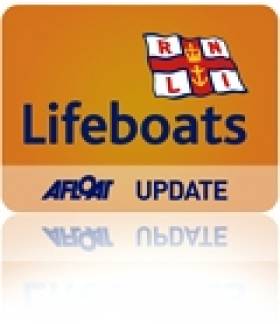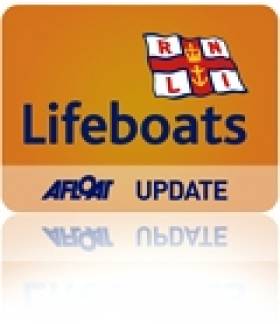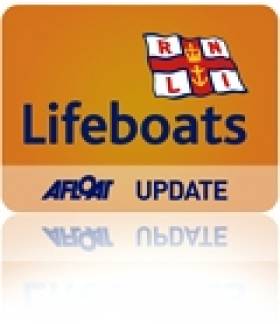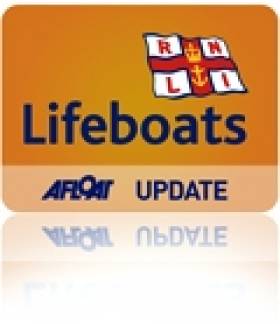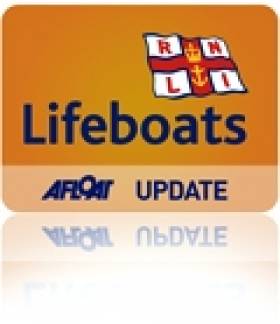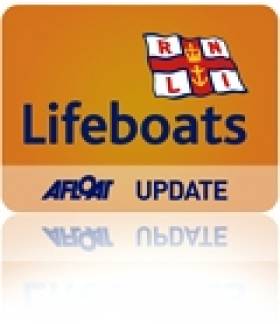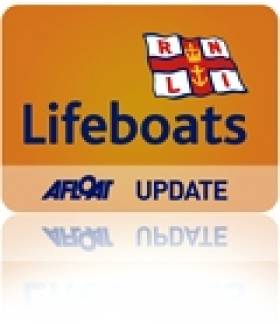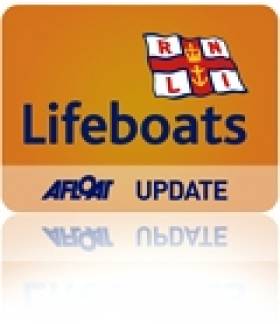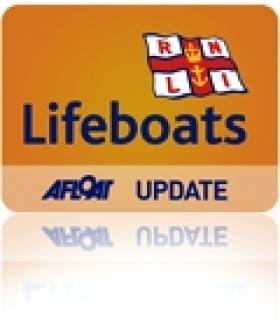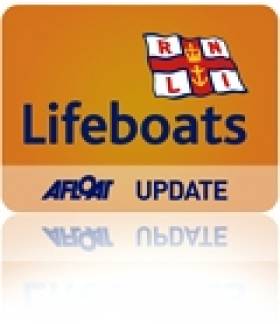Displaying items by tag: Lifeboats
Arklow Lifeboat Rescues Two From Sinking Yacht
#RNLI - Arklow RNLI's all-weather lifeboat Ger Tigchelaar was launched yesterday afternoon (Saturday 5 April) to a report of a sailing vessel in danger of sinking off the Wicklow coast.
With challenging seas and with visibility deteriorating, the lifeboat proceeded to the scene approximately four miles east of Arklow.
Upon arrival, two Arklow RNLI volunteers were put aboard the stricken 33ft vessel with salvage pumps in an effort to prevent the yacht from sinking.
After efforts to pump out the vessel proved unsuccessful, the yacht's crew of two were evacuated to the lifeboat.
During the rescue, the Commissioners of Irish Lights vessel Granuaile and Irish Coast Guard helicopter Rescue 116 were been tasked to the scene.
With the stricken yacht almost beneath the surface, lines were passed to Granuaile from the yacht, which was then secured to the deck of the larger Granuaile.
And with additional salvage pumps put aboard, the yacht was then pumped out and the ingress of water was stemmed.
The lifeboat stood by and our volunteers tended to the two rescued men as the vessel was pumped out. The Granuaile's crew then handed the lines of the yacht back to the Arklow lifeboat crew and a towline was established before heading back to Arklow Harbour.
Arklow RNLI press officer and sea safety officer Mark Corcoran said: “The professionalism shown by Arklow RNLI’s volunteers, Commissioners of Irish Lights crew members and our coastguard colleagues overhead, not only helped save two lives today, [but] the dedication and bravery by all involved also helped us to save the sinking vessel and return her safely to Arklow.
"This shows how all of our training and exercising with the other agencies on our coast pays off.”
#RNLI - Arklow RNLI’s dedicated volunteers were delighted to be awarded the top prize at this year's St Patrick's Day Parade in Arklow.
This year saw the highest number of parade entries for the Co Wicklow town, including three floats paraded by lifeboat volunteers and fundraisers alike - all of whom had an early start on the day!
Speaking yesterday, chair of fundraising Michael Mordaunt said: “I am simply delighted our St Patrick's Day parade crew have received this award.
"The St Patrick's Day parade is a great opportunity for ourselves as a charity to showcase some of the other events we hold throughout the year to a very large audience.
"As well as this, it is one of the best opportunities we have in the year to say thank you to all of our local supporters.”
The RNLI's next big fundraising drive will be its annual Mayday event in a little over a month from now.
Courtown Lifeboat Rescues Driver From Submerged Dump Truck
#RNLI - Courtown RNLI's lifeboat was launched on Saturday evening (1 March) to reports of a dump truck submerged off Ardamine Beach in the Wexford town.
The driver of the 25-tonne dump truck had managed to get out of the cab and onto the bonnet before the tide completely submerged it.
He was rescued from the top of the vehicle by the lifeboat crew of Glen Deacon, Áine Stafford and James Mahon and taken back to the lifeboat station.
The truck was later recovered from the sea at the next low water.
Bangor Lifeboats Rescues Four From Stricken RIB
#RNLI - Bangor RNLI received a request from Belfast Coastguard yesterday evening (1 March) to launch their lifeboat and assist four people onboard a 23ft rigid inflatable boat, or RIB, that experienced engine failure north of Ballyholme Bay on the southern shores of Belfast Lough.
Within minutes of their rescue pagers being activated, the crew had assembled and had launched their inshore lifeboat, which proceeded at full speed towards the stricken vessel.
Upon arrival, the crew found that the four on board the RIB, who were experienced mariners, had followed procedure and made the correct decision to call for assistance at the first sign of trouble.
Calm on scene, weather conditions allowed for a tow line to be quickly rigged, and the vessel was then taken under tow to the safety of Bangor Marina.
Following the rescue, RNLI volunteer helmsman Iain Dobie took the opportunity to underline an important safety message.
"We always urge everyone going afloat to make sure their engine and fuel systems and are well maintained and in good working order," he said. "Engine failure close to shore and commercial shipping routes could lead to a life threatening situation."
Dobie added: "We're happy that everyone is now safely ashore."
RNLI Marks Centenary Of Fethard Lifeboat Tragedy
#RNLI - One hundred years ago, nine volunteer lifeboat crew from Fethard RNLI lost their lives as lifeboat crews rescued 10 people after Norwegian vessel, the Mexico, struck rocks off the Wexford coast.
Hundreds of people gathered to attend events in Wexford this weekend to mark the centenary of the Fethard lifeboat tragedy.
At Fethard Quay, four RNLI lifeboats from Fethard, Rosslare, Dunmore East and Kilmore Quay gathered, and their lifeboat crews lay wreaths in the sea from the lifeboat stations, relatives of the lifeboat men who were lost and of those who survived, along with wreaths from relatives of the crew of the Mexico who had travelled from Norway for the anniversary.
Portrush Lifeboat Helm Trained To Help With Flood Rescue
#RNLI - Portrush RNLI volunteer Karl O’Neill is becoming one of the RNLI's all-rounders, for as well as being helm for the Portrush inshore lifeboat and senior RNLI lifeguard, he is now a part of the lifesaving charity's Flood Rescue Team (FRT).
The FRT is available 24 hours a day, seven days a week to deploy to flooding events in the UK, Ireland and abroad for search and rescue (SAR) operations.
The team comprises RNLI members from across the network who have been specially trained for the risks involved when working in or around fast moving flood water. The team are all either serving volunteer lifeboat crew or operational RNLI staff who volunteer to be part of the team.
As part of his training, O'Neill had to go to Loch Etive, near Oban in Scotland, for a period of four days' intensive training. The training exercises are designed to ensure that the team are fully prepared for dangerous and unpredictable flood waters, which differ greatly from the sea environment.
These exercises allow the volunteers to practise their skills in fast-flowing water, simulating the conditions they could face in a real life situation.
"It was a great experience to be trained for this type of emergency and has equipped me to respond in an emergency when the call comes," said O'Neill on his return to station.
"The training I had already received from the RNLI had given me a good foundation already, but the flood water training was very different to being in the open sea."
Lifeboat operations manager Robin Cardwell added that "the team at Portrush are very proud of Karl in terms of this training. He will be a great asset to any of the FR Teams when called to respond."
Karl O'Neill's family has a long association with Portrush Lifeboat Station, as his grandfather was a mechanic and cox, his uncle Anthony Chambers is the present mechanic and RNLI Bronze Medal awardee, and his cousin Jason Chambers is also on crew.
In other Portrush news, O'Neill and his inshore lifeboat crew got their first service of 2014 last Sunday (16 February) just after their usual training session, when they were called to the assistance of two surfers who got into difficulties off Portstewart Strand.
The weather was unusually mild for a Sunday in February and perfect conditions for surfing. However, the surfers were caught in strong currents and were swept out to sea.
The Inshore lifeboat quickly located the first surfer and got him on board. They then found the other surfer and, after getting him on board, transported both surfers back to the beach.
"It was a beautiful day for surfing on the North Coast but it goes to show that everyone needs to be mindful about sea safety," said Cardwell.
Wicklow Lifeboat Attends Fishing Boat With Engine Failure
#RNLI - Wicklow RNLI's all-weather lifeboat launched shortly before 4pm yesterday afternoon (Wednesday 19 February) to assist a fishing vessel in difficulties off Wicklow Head.
The skipper of the fishing vessel contacted the Irish Coast Guard for assistance after his vessel developed engine failure in a position east of Wicklow Head.
The lifeboat, under the command of coxswain Dave O'Leary, located the fishing vessel twenty-five minutes after launching.
Weather conditions in the area were described as wind direction south easterly, force six to seven with a three metre swell.
A towline was quickly established, but progress with the tow was slow returning back to Wicklow due to wind and tidal conditions.
The fishing vessel with three crew was finally secured safely alongside the Packet pier at Wicklow Harbour at 7.45pm.
Lifeboat crew on the callout were coxswain Dave O'Leary, mechanic Brenda Copeland, Carol Flahive, Brian Sinnott, Tommy Murphy and John Vize.
Keith Barry 'Brain Hacker' Supports RNLI at Angling Exhibition
#brainhacker – Celebrity 'Brainhacker' Keith Barry shows his support for the RNLI at the recent angling exhibition (L-R) George Duffy (Howth RNLI), John McKenna (Lifeboat Sea Safety Officer, Howth RNLI), Keith Barry and Alan Gielty (Achill Island RNLI) pictured at the RNLI stand at the Ireland Angling 2014 exhibition in Dublin (15 Feb 2014). Over 300 people visited the stand to get advice about staying safe at sea and how to properly maintain their lifejackets.
Out of the 18 lifejackets brought to the Lifejacket Clinic, 14 had out-of-date triggers or salt tablets and one had been fired.
Smiles All Round For RNLI In SOS Day Fundraisers
#RNLI - Wicklow RNLI was delighted to welcome members of the Wicklow Kilmantin Arts Group, who presented a cheque for €500 to the station last Friday (31 January).
The money was raised during a recent art auction in Wicklow, and the local artists' group wanted some of the proceeds to go to a local charity.
Mary De Courcy, chairperson of the fundraising branch, accepted the generous donation on behalf of the station.
Speaking after the presentation, Wicklow RNLI volunteer lifeboat press officer Tommy Dover said the station was delighted to receive the gift "especially on SOS Day, one of the RNLI’s main fundraising days."
SOS Day is the annual RNLI crew fundraising day and stations all over the country host innovative and novel ways of fundraising incorporating the SOS initials.
In Northern Irelabd, supporters of Portrush Lifeboat Station jumped into the sea at Portrush Harbour and swam round the station's all-weather lifeboat, the William Gordon Burr.
The weather was bitterly cold but didn’t deter the crowd that turned up to do their bit.
- RNLI coxswain Des Austin explained: "This is a fun event that involves our crew, fundraisers, and a great local crowd who turn out irrespective of the weather to support the volunteer lifeboat crew.
"The crew themselves take part and their colleagues and on standby to give them a friendly push and also to haul them in at the end of the swim."
The man with the megaphone for the event was Robin Cardwell, Portrush RNLI lifeboat operations manager. All swimmers were counted out and counted back in again.
The crew thanked Coleraine Borough Council for their use of Waterworld for everyone to get a hot shower after their swim, as well as the RNLI lifeguards and the local coastguard team, who provided safety cover for the event.
After the event everyone was treated to homemade soup and sandwiches in Portrush Yacht Club, and a special SOS cake made by crew member Claudia McAlpin.
RNLI In Dispute With Coastguard Over Trawler Emergency
#RNLI - The Irish Independent says that the RNLI wants a meeting with the Irish Coast Guard over an incident off Dublin last weekend that it was not called to attend.
According to reports, the coastguard sent its closest rescue helicopter from Dublin Airport to attend an emergency on the fishing trawler Fragrant Cloud in Killiney Bay, despite the availability of an RNLI lifeboat crew in nearby Dun Laoghaire.
More on this story as it develops.


























